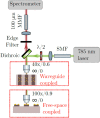Integrated enhanced Raman scattering: a review
- PMID: 34860308
- PMCID: PMC8642575
- DOI: 10.1186/s40580-021-00290-7
Integrated enhanced Raman scattering: a review
Abstract
The demand for effective, real-time environmental monitoring and for customized point-of-care (PoC) health, requires the ability to detect low molecular concentrations, using portable, reliable and cost-effective devices. However, traditional techniques often require time consuming, highly technical and laborious sample preparations, as well as expensive, slow and bulky instrumentation that needs to be supervised by laboratory technicians. Consequently, fast, compact, self-sufficient, reusable and cost-effective lab-on-a-chip (LOC) devices, which can perform all the required tasks and can then upload the data to portable devices, would revolutionize any mobile sensing application by bringing the testing device to the field or to the patient. Integrated enhanced Raman scattering devices are the most promising platform to accomplish this vision and to become the basic architecture for future universal molecular sensors and hence an artificial optical nose. Here we are reviewing the latest theoretical and experimental work along this direction.
Keywords: Artificial nose; Enhanced Raman scattering; Molecular sensor; Nanophotonic sensor; Optical nose; Plasmonics.
© 2021. The Author(s).
Conflict of interest statement
The authors declare that they have no competing interests.
Figures


















References
-
- Buck L, Axel R. A novel multigene family may encode odorant receptors: a molecular basis for odor recognition. Cell. 1991;65(1):175–187. - PubMed
Publication types
LinkOut - more resources
Full Text Sources
Miscellaneous
